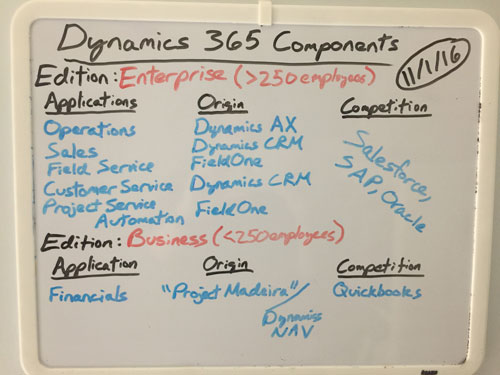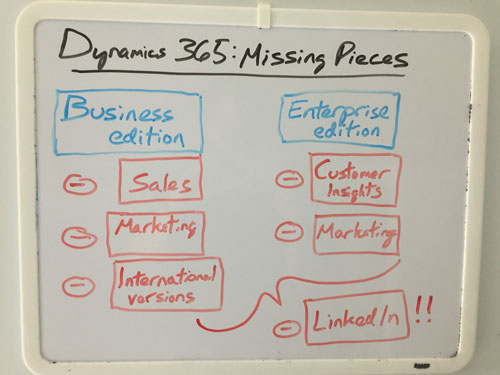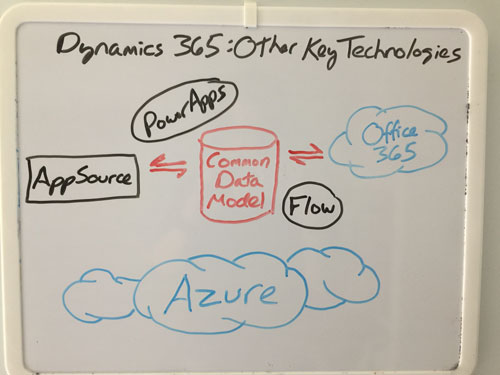Whiteboarding Microsoft Dynamics 365
Microsoft Dynamics 365 is the company's most substantial move on business applications since entering the market in 2000 with the acquisition of Great Plains.
With Dynamics 365, Microsoft is adding business applications into the main effort of its strategic approach to the future of technology -- offering a single product to meet many customers' needs that fits the existing mantra of "cloud-first, mobile-first," and peppering it with the emerging emphasis on AI-first.
Previously, the business applications -- CRM and the ERP suites AX, SL, GP and NAV -- existed outside Microsoft's main infrastructure businesses. They often seemed like a side hustle for Redmond. When Dynamics 365 launches on Nov. 1, Microsoft seems to want customers and partners to view Dynamics 365 as one of its core offerings.
At a launch event Tuesday, Microsoft offered a soaring pitch for the suite. "Dynamics 365 [is] our new cloud service with purpose-built apps that enable you to address specific business needs (like sales automation, operations or customer service) and start small with the assurance that the solution can grow as your needs do. Powered by advanced analytics and machine learning -- what we call Intelligence -- Dynamics 365 will usher in a new era of business agility for you, our customers," said Takeshi Numoto, corporate vice president for Microsoft Cloud and Enterprise, in a blog post.
Numoto went on to describe Microsoft's ambitions for the suite: "Designed to help improve manufacturing and supply chain execution, make field service operations more efficient, sell more effectively and ultimately deliver exceptional customer experiences, built-in intelligence capabilities are infused throughout Dynamics 365 apps including: sentiment and intent analysis, preemptive service, relationship insights, lead and opportunity scoring, product recommendations and up-sell/cross-sell, and many more."
Those capabilities all have to be constructed and developed from existing pieces of Microsoft's IP, and packaged into new components, some of which will be ready at launch, others of which will arrive later.
I've sketched out a few diagrams on the whiteboard on my office wall to clarify what the suites are, what the components will be, where those components come from and when different pieces will be available.
 [Click on image for larger view.] Figure 1: Dynamics 365 components.
[Click on image for larger view.] Figure 1: Dynamics 365 components.
When Dynamics 365 becomes generally available on Nov. 1, it will be offered in two editions, Enterprise and Business. Broadly, the design goal was to make Enterprise appropriate for companies with more than 250 employees and Business for companies with fewer than 250 employees. At least at launch, Enterprise is a much, much more full-featured package than Business. If you think about the competitive set -- think Salesforce, SAP and Oracle as the competition for Enterprise and think QuickBooks as the competition for Business -- most of the demo capabilities shown on Tuesday and the built-in intelligence capabilities that Numoto blogged about would appear to skew heavily to the Enterprise side of Dynamics 365.
Recognizing that every customer is different -- some small shops have substantially more sophisticated requirements than some larger shops -- the 250-employee cutoff is not a hard-and-fast rule. Microsoft will sell the Enterprise edition with as few as 20 seats, and customers can buy up to 300 seats of the Business edition.
Speaking of seats, named user subscriptions are the primary way that Microsoft plans to license Dynamics 365, although a device licensing option will be available for things like kiosks or warehouse tablets that shift workers might use. Microsoft envisions two kinds of users of Dynamics 365 -- full users and light users. Full users will either buy a plan, which gives them access to all of the applications inside their Dynamics 365 edition, or a license specific to one application, which also includes rights to PowerApps that might access data from other applications. For light users, companies will buy Team Member subscriptions at a much lower price per seat. Those subscribers would be able to do things like update their timecards, enter expenses or update their human resource records inside Dynamics 365.
By describing the applications, it starts to become clear what kinds of capabilities the suite will deliver on Day 1 versus what it will only be able to deliver after additional components arrive. At launch on Nov. 1, Microsoft will offer five applications in the Enterprise edition and only one application in the Business edition.
The Enterprise edition applications are Dynamics 365 for Operations, Dynamics 365 for Sales, Dynamics 365 for Customer Service, Dynamics 365 for Field Service and Dynamics 365 for Project Service Automation.
Dynamics 365 for Operations is the full-bore ERP component of the Enterprise edition, and Microsoft chose Dynamics AX as the source product to provide the underlying capabilities of this application. Operations will be the most expensive application of the five to subscribe to by quite a bit, a move Microsoft justifies based on the relatively small number of users who require full-fledged ERP capabilities. The choice of AX as opposed to GP, SL or NAV makes sense in light of the complete re-architecting of the product for release earlier this year as an Azure-first ERP system.
Dynamics 365 for Sales and Dynamics 365 for Customer Service are two applications representing core CRM capabilities, and both seem to depend primarily on elements that were already included in Dynamics CRM Online.
The other two applications are Dynamics 365 for Field Service and Dynamics 365 for Project Service Automation. According to Forceworks and RapidStartCRM CEO Steve Mordue, who blogs regularly about Dynamics 365, both applications seem to come from Microsoft's July 2015 acquisition of FieldOne, a field-service application that was already integrated with Dynamics CRM. "This ultimately turned in a twofer, as the core resource scheduler of Field Service was forked by Microsoft to create Project Service, their PSA solution," Mordue wrote last week in a insightful analysis of former Microsoft CRM boss Bob Stutz's acquisition spree.
The Business edition at this point contains only one application, Dynamics 365 for Financials. It is the productization of "Project Madeira," which Microsoft made available in a public preview in April. Madeira was a Software as a Service (SaaS) small and midsize business (SMB) management solution that is based on the Dynamics NAV platform, tightly integrated with Microsoft Office, multitenant and hosted in the Azure public cloud.
 [Click on image for larger view.] Figure 2: Missing Dynamics 365 pieces at launch.
[Click on image for larger view.] Figure 2: Missing Dynamics 365 pieces at launch.
Some of the core components required to light up a lot of Dynamics 365 functionality won't be available immediately at launch.
Probably coming on the Enterprise edition side, there's the Dynamics 365 for Customer Insights application. Based on the Cortana Intelligence Suite, Numoto wrote that Customer Insights, which was unveiled on Tuesday, "connects and analyzes data from Microsoft -- and other widely used CRM, ERP, web, social and IoT sources -- and applies intelligence to it to give you a 360-degree customer view with automatic suggestions to improve engagement." Customer Insights is scheduled for availability in December.
In some earlier documentation, Microsoft listed plans to release a Marketing application for the Enterprise edition, but it's not clear yet what technology that product would be based on. One possibility is the Adobe Marketing Cloud. In an announcement from Microsoft Ignite last month about the partnership, the companies stated that "Microsoft will make Adobe Marketing Cloud its preferred marketing service for Dynamics 365 Enterprise edition, giving customers a powerful, comprehensive marketing service for Microsoft's next generation of intelligent business applications." Mordue blogged separately last week that he's been told by Microsoft that the Marketing app has been canceled in favor of using Adobe. RCP hasn't been able to confirm that with Microsoft yet.
On the Business edition side, Microsoft also has placeholders for business applications covering Sales and Marketing. The Business edition will also only be available immediately in the United States and Canada. Versions for other geographies are all coming later.
There was little mention this week either about what role Microsoft's LinkedIn acquisition might play in the Dynamics 365 lineup. Given the obvious advantages of LinkedIn's professional social network platform and data for CRM, it's safe to assume substantial integration in the future.
 [Click on image for larger view.] Figure 3: Other key Dynamics 365 technologies.
[Click on image for larger view.] Figure 3: Other key Dynamics 365 technologies.
While the availability of the discrete business applications will be critical to unlock much of Dynamics 365's promise, there are other Microsoft technologies that undergird, connect and integrate the Dynamics 365 applications and solutions. Some, like AI, Internet of Things and chatbots will become more important later. There are a few that Microsoft is using already on a broad basis across the suite.
Microsoft's Azure public cloud has a starring role -- it's the platform on which all of the Dynamics 365 products and functions are being built. Other technologies being touted heavily by Microsoft right now that partners and customers will need to understand to get the most out of Dynamics 365 include:
- Common Data Model: Microsoft's out-of-box business database for storing and managing business entities.
- PowerApps: Microsoft's service for building and using custom business apps that connect to data and work across the Web and mobile.
- Flow: Microsoft's SaaS offering for automating workflows across business users' applications and SaaS services.
- AppSource: A marketplace for partner applications.
- Office 365: Microsoft's SaaS-based productivity suite, which is heavily integrated with Dynamics 365.
The technologies Microsoft will roll out as Dynamics 365 on Nov. 1 represent a big step forward in Microsoft's business applications story. But it looks like it will be mid-2017 or later before some important elements become available.
Posted by Scott Bekker on October 14, 2016